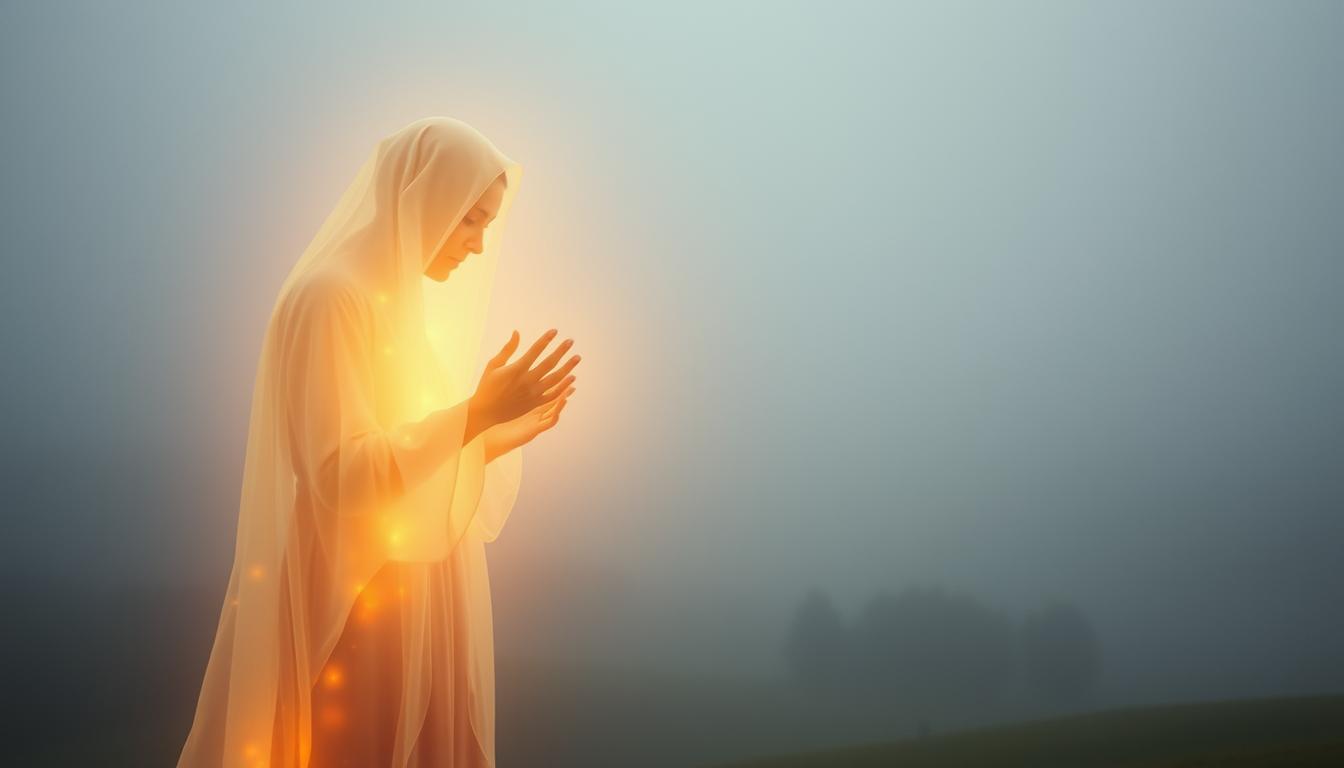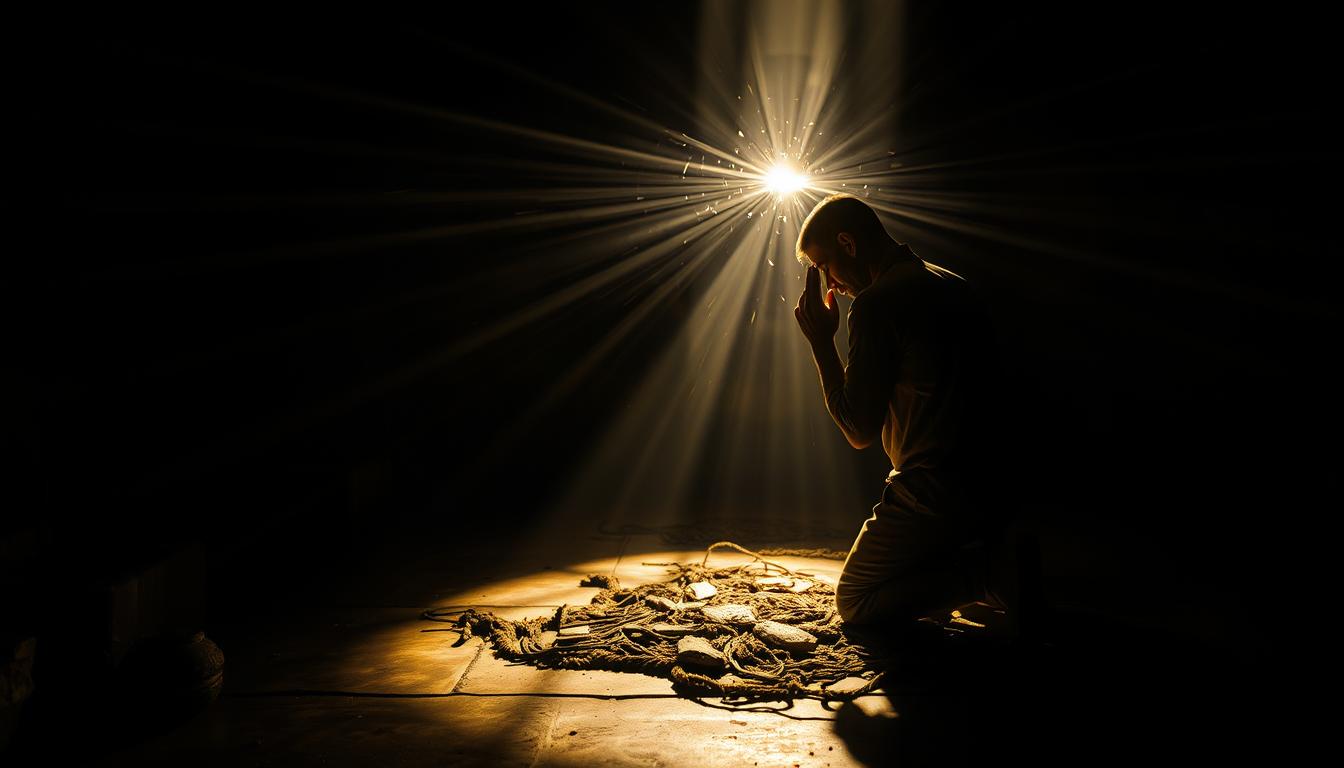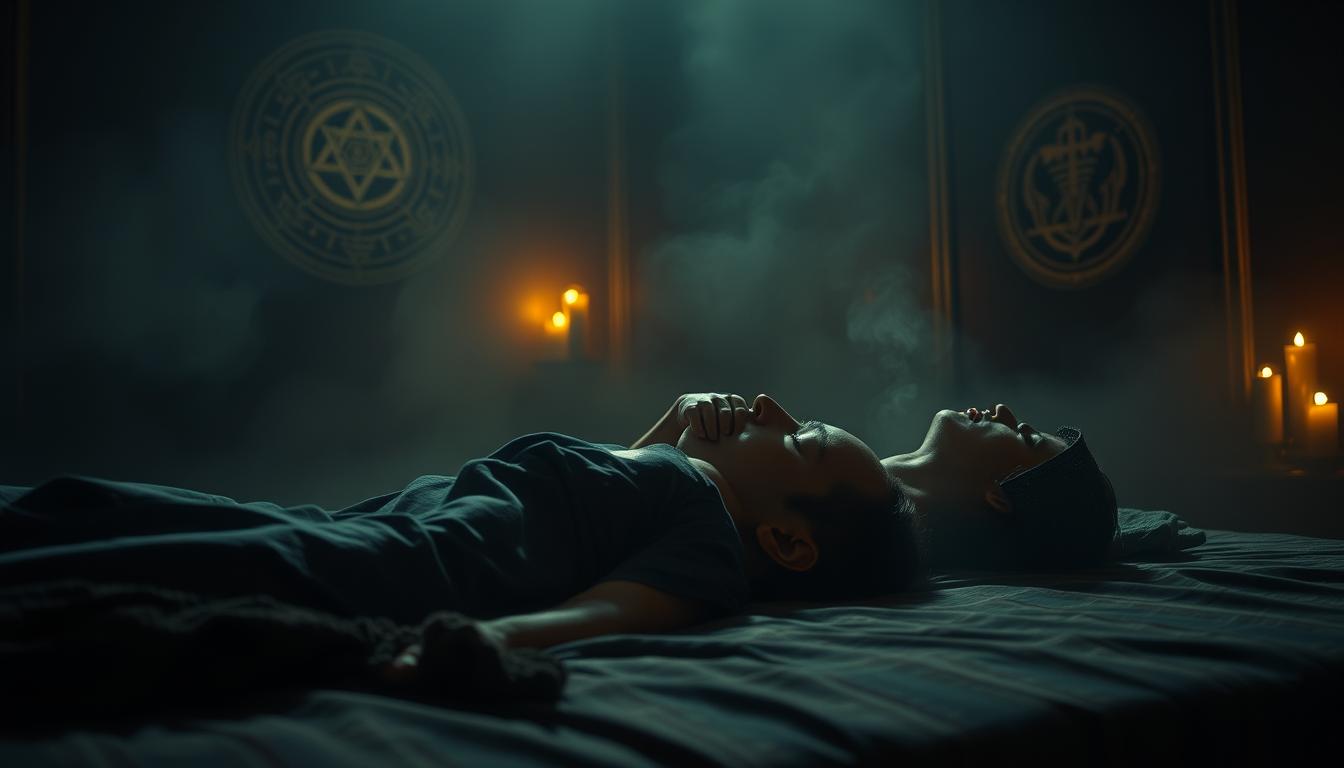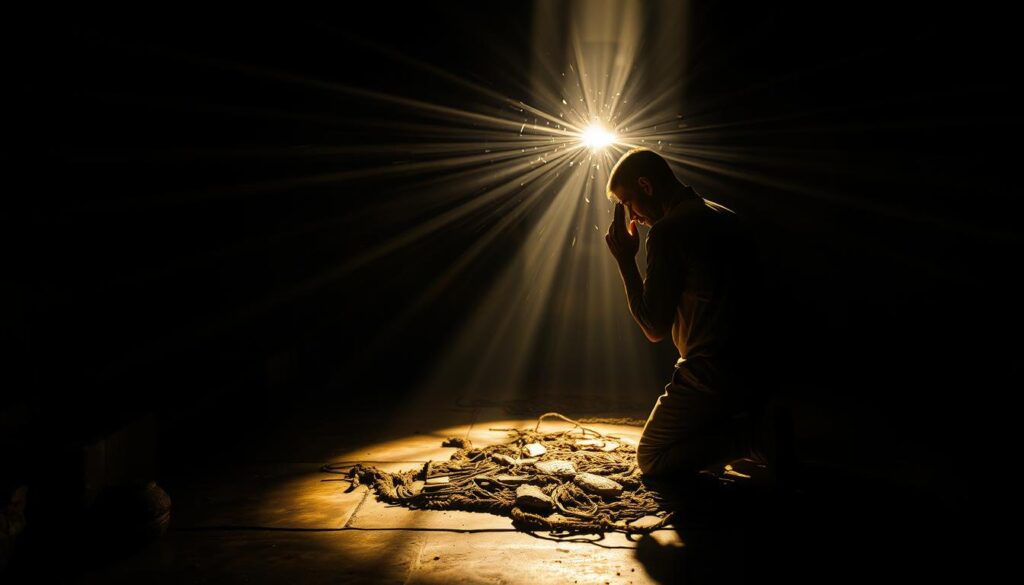Dreams about deceased loved ones are mysterious and emotionally charged. When a dead person touches you in a dream, it can trigger deep feelings. These feelings go beyond what we experience in our waking lives.
Experts say these dreams are not just random thoughts. They might show unresolved emotional connections, help us process grief, or offer spiritual guidance from beyond.
Feeling warmth, comfort, or a strong connection is common in these dreams. People often report these sensations when they dream of touching loved ones who have passed away.
Studies show that these dreams help with emotional healing. They might help you deal with loss, unfinished emotional business, or find closure after a big loss.
Looking at these dreams through spiritual, psychological, or scientific views, they show complex emotional landscapes. They invite us to reflect on our grief journey and understand ourselves better.
Understanding Dream Encounters with the Deceased
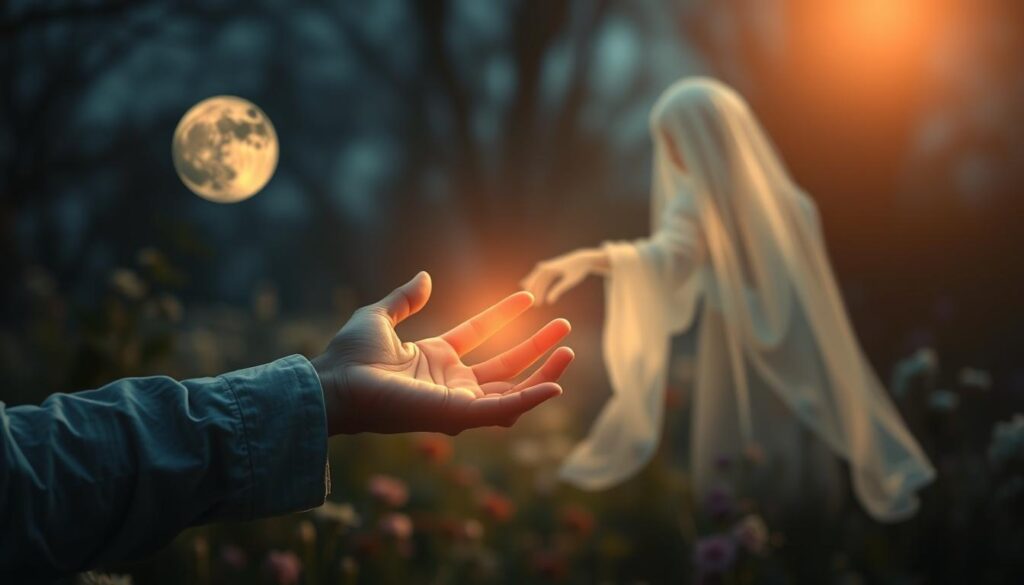
Dreams about deceased loved ones can be very emotional. They touch the deepest parts of our minds. These dreams often mean more than regular dreams.
Looking into dream analysis shows us how our minds deal with grief and memories. These dreams are not just random. They are complex stories that help us cope with loss.
Physical Contact in Dreams
Dreams about touching the deceased can feel very real. People often say they feel physical touch that feels real:
- A warm embrace that feels comforting
- A gentle hand on the shoulder
- An unexpected tap or gentle nudge
Common Touch Sensations
The feelings in these dreams can be very vivid. Some people say these touches feel:
- Electrically charged
- Deeply calming
- Filled with unexplained warmth
Emotional Responses to Dream Contact
When a deceased loved one touches you in a dream, it can be very emotional. Some feel overwhelming peace. Others feel joy, sadness, and a deep connection.
These dreams help us deal with feelings we can’t resolve. They offer a special way to heal and find closure.
The Spiritual Significance of Being Touched by the Dead

Dreams where a deceased loved one touches you are more than just dreams. They show a deep spiritual bond that goes beyond life and death. These dreams often hold deep emotional and spiritual meanings.
Different spiritual views see these dreams as special moments of connection. The touch in these dreams can mean many things:
- Emotional healing and closure
- Spiritual guidance from beyond
- Unresolved relationship dynamics
- Spiritual communication and protection
In many beliefs, the soul lives on after death. Visitation dreams are real moments of connection between the spiritual and physical worlds. They offer comfort, insight, and a sense of ongoing connection with those who have passed.
Energy workers and spiritual experts say these dreams can mean:
- Unfinished emotional business
- A message of reassurance
- A spiritual blessing or protection
- An invitation to personal growth
Understanding these dreams needs an open mind and a willingness to explore the human experience. Each dream touch has its own special meaning. It invites us to think about our spiritual and emotional journeys.
What Does It Mean When a Dead Person Touches You in a Dream?
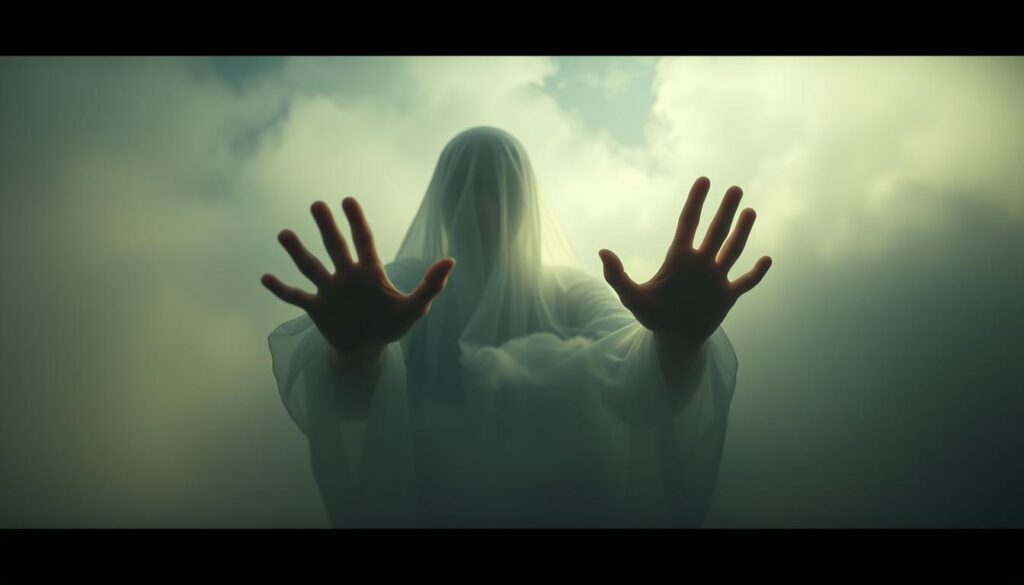
Dreams about loved ones who have passed away are very meaningful. They show us messages from beyond our world. These messages connect us to spiritual realms.
When someone who has died touches you in a dream, it can mean a lot. It’s not just a random dream. It’s a way for them to communicate with you.
Messages from Beyond
Experts say these dreams are real attempts to share important insights. The touch in these dreams can mean:
- Unresolved emotional connections
- Guidance from spiritual realms
- Unconscious processing of grief
- Transmitting critical personal wisdom
Warning Signs and Premonitions
Some think these dreams are warnings. They might signal:
- Potential upcoming life challenges
- Necessary personal transformations
- Unacknowledged emotional blockages
- Spiritual awakening indicators
Comfort and Reassurance
Dreams about deceased loved ones often bring emotional healing. Subconscious dream messages in these dreams aim to reassure us. They show us that our connections with them never truly end.
To understand these dreams, we need to reflect and analyze them deeply. Each dream is unique and carries its own emotional message.
Processing Grief Through Dream Encounters
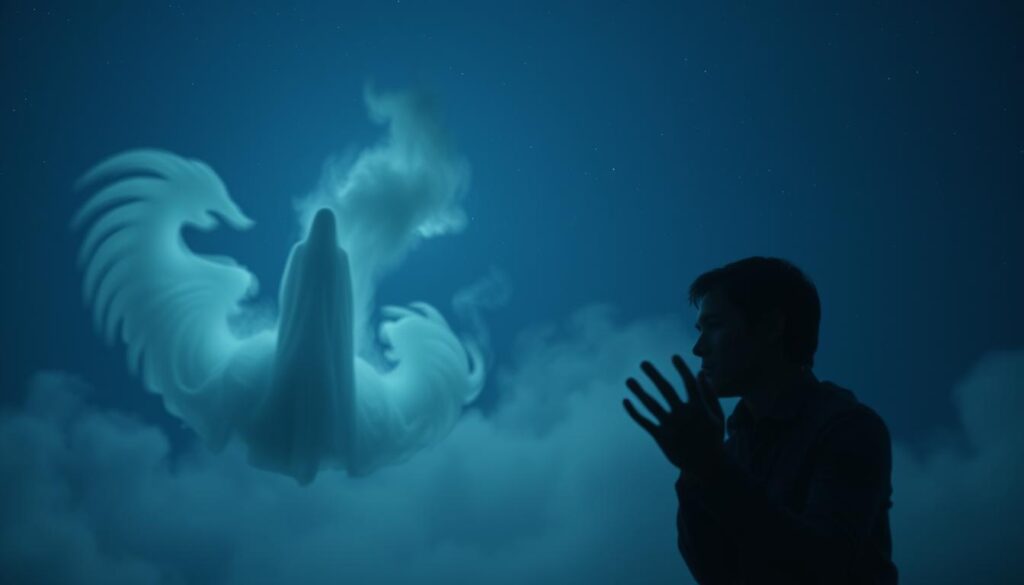
Dreams are a powerful tool for healing, helping us deal with grief. When we dream of loved ones who have passed away, it can be a special way to heal. These dreams offer a safe place to explore and understand our feelings of loss.
Through dreams, we can connect with our loved ones in ways we can’t in real life. Our subconscious mind creates a space where we can face our emotions freely. This space is free from judgment and limits.
- Dreams facilitate emotional processing of loss
- Provide a safe space for exploring difficult feelings
- Allow symbolic interactions with deceased loved ones
- Help manage intense emotional experiences
Research shows that dream encounters can help in many ways. They might help you:
- Acknowledge your grief
- Release unexpressed emotions
- Find closure or resolution
- Create meaningful memories
By understanding the role of dreams in healing, we can turn our grief into a journey of growth and healing.
Cultural Interpretations of Dead Person’s Touch

Dreams mean different things in various cultures. Cultural dream symbolism shows how societies see spiritual links between the living and the dead. Each culture has its own way of understanding dreams about those who have passed away.
Different cultures see dreams about the dead in their own special ways. These views show deep beliefs about the soul, talking to spirits, and the line between the world we see and the world we don’t.
Eastern Perspectives
In Eastern cultures, touching a dead person in a dream often means getting spiritual advice and talking to ancestors. Key points include:
- Respect for ancestral spirits as wisdom carriers
- Dreams as channels for receiving messages
- Emphasis on emotional and energetic connections
Western Beliefs
In Western cultures, dreams about the dead are seen as a way to deal with emotions and heal. Western views see these dreams as:
- Manifestations of unresolved grief
- Subconscious attempts to reconcile loss
- Potential symbolic representations of personal transformation
Indigenous Traditions
Indigenous cultures see dreams as sacred spiritual events. Their unique view includes:
- Direct communication with ancestral spirits
- Dreams as prophetic or warning mechanisms
- Holistic understanding of life and death
| Cultural Perspective | Dream Touch Interpretation | Spiritual Significance |
|---|---|---|
| Eastern | Ancestral guidance | Wisdom transmission |
| Western | Emotional processing | Psychological healing |
| Indigenous | Spiritual communication | Prophetic messages |
These different views show that dreams are more than just our minds working. They are deep spiritual talks that connect us to other worlds.
Psychological Analysis of Death-Related Dreams

When we dream about touching loved ones who have passed away, it’s a deep look into our subconscious. These dreams help us deal with grief and emotions. They show how our minds process complex feelings.
Experts in dream analysis see these dreams as symbols of unfinished emotional states. Our subconscious uses dreams to talk to us. It helps us understand and deal with feelings of loss and memory.
- Dreams serve as emotional processing platforms
- Subconscious dream messages reflect inner psychological dynamics
- Touch symbolizes connection beyond physical separation
Death-related dreams have many layers of emotional meaning. Dreams do not merely replay memories. They create stories that help us cope with hard experiences and feelings of separation.
These dream encounters are seen as:
- Emotional resolution mechanisms
- Unconscious attempts to maintain connections
- Metaphorical representations of internal healing processes
Looking into these dreams can give us a better understanding of our emotions and growth. It helps us see our inner world more clearly.
Unresolved Emotions and Dream Manifestations

Dreams are a powerful way for our emotions to speak. They help us deal with feelings we can’t talk about when we’re awake. Our minds create a safe place for us to explore deep feelings without fear of real-world problems.
Our subconscious mind uses dreams to heal our emotions. When we dream of loved ones who have passed away, they often symbolize feelings we haven’t dealt with yet.
Guilt and Regret
Unresolved guilt can show up in dreams in big ways. Our subconscious might set up scenarios where:
- Deceased loved ones offer forgiveness
- Unspoken conversations become possible
- Emotional burdens are symbolically released
Longing and Attachment
Dreams help us connect with what we’ve lost. They give us a special space to feel close to those we miss. This helps us deal with our grief in a unique way.
| Emotional State | Dream Manifestation | Psychological Interpretation |
|---|---|---|
| Deep Longing | Comforting Touch | Seeking Emotional Closure |
| Unresolved Grief | Repeated Dream Encounters | Subconscious Processing |
| Emotional Attachment | Vivid Sensory Interactions | Maintaining Emotional Connection |
Fear and Anxiety
Anxiety about loss can lead to intense dreams. Psychological dream analysis shows these dreams are not just random. They are our mind’s way of processing deep emotions and navigating complex feelings.
The Role of Touch in Dream Symbolism

Dreams offer deep insights into our subconscious, focusing on spiritual meanings through touch. Touch is a key way our physical and spiritual worlds communicate.
When a loved one who has passed away touches you in a dream, it can mean many things. Dreams give us unique experiences that go beyond everyday life. The feeling of touch in dreams can carry different messages about our emotions and spirit.
- Emotional reconnection with the departed
- Unresolved feelings seeking resolution
- Spiritual guidance from beyond
- Subconscious processing of grief
The spiritual meaning of touch in dreams can change based on the dream’s context and feelings. Some people feel warmth, comfort, or peace. Others might feel complex emotions that need more thought.
Experts say touch in dreams is like a bridge between memory and spirit. It helps share emotions, messages, and understanding in a special way.
To understand these dreams, we need to be open and explore spiritual connections. Each touch in a dream is important. It invites us to think about our feelings and spiritual bonds.
Distinguishing Between Memory Dreams and Visitation Dreams
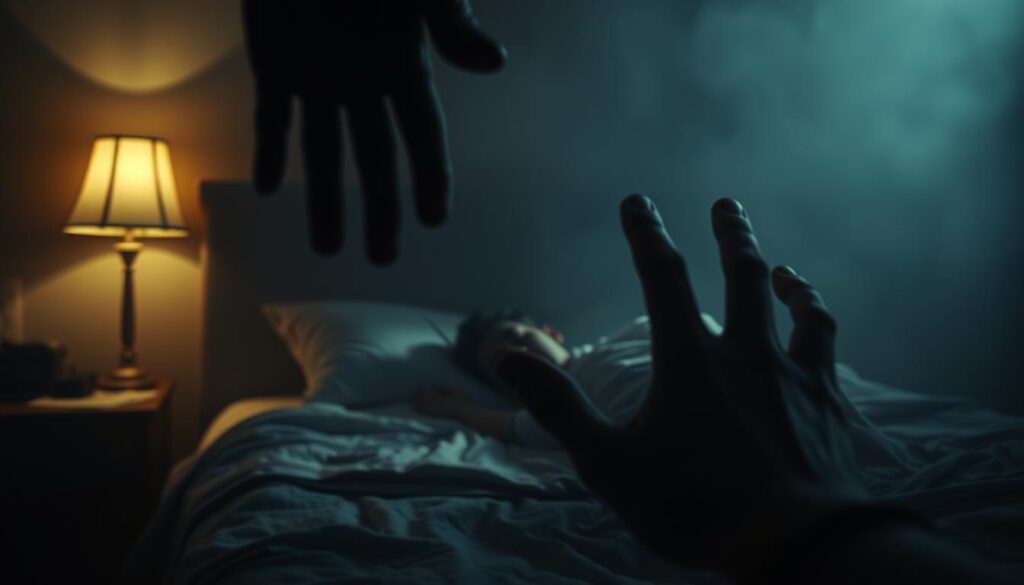
Understanding the difference between memory dreams and visitation dreams can give us deep insights. Both involve loved ones who have passed away. Yet, they have unique emotional and spiritual qualities.
Dream researchers have found key differences to spot visitation dreams:
- Memory dreams replay past experiences
- Visitation dreams are more vivid and emotionally charged
- Spiritual encounters leave a lasting emotional mark
Characteristics of Memory Dreams
Memory dreams are how our brain processes past experiences. They often:
- Recreate specific moments from the past
- Feel nostalgic but lack deep emotions
- Seem fragmented or disconnected
Signs of Spiritual Visitation
Visitation dreams have unique signs of a deeper spiritual connection. They often involve direct communication and deep emotional experiences.
| Memory Dream Traits | Visitation Dream Traits |
|---|---|
| Passive recollection | Active spiritual interaction |
| Less emotional intensity | Profound emotional resonance |
| Disconnected narrative | Clear, meaningful communication |
Knowing the differences between memory and visitation dreams helps us understand our subconscious. It also helps us connect with our departed loved ones on a deeper level.
Healing and Closure Through Dream Encounters

Dreams about loved ones who have passed away can be very healing. When you dream that someone you lost touches you, it might mean more than you think. These dreams can be a special kind of therapy, helping you deal with hard feelings and find peace.
Your dreams can lead you to healing in ways you might not expect. Dreams with the deceased often show us parts of ourselves we need to look at and understand.
- Recognize the symbolic meaning behind dream touches
- Understand the emotional significance of these encounters
- Use dream experiences as personal healing opportunities
Dream therapy says these special moments in dreams can deeply help us deal with grief. The feeling of being touched in your dream might mean:
| Dream Touch Symbolism | Emotional Interpretation |
|---|---|
| Gentle Touch | Comfort and Reassurance |
| Firm Grip | Guidance and Support |
| Distant Touch | Unresolved Emotions |
Every dream interaction is a chance to find emotional peace. By being open and curious, you can turn grief into a journey of growth and insight.
Karmic Connections in Dreams of the Dead

Spiritual dreams show deep links between our lives and our spiritual side. Visitation dreams often point to deep karmic ties that go beyond life. These dreams hint at a spiritual web where our actions and feelings keep interacting after we pass away.
Karma is a complex spiritual force that links souls across different realms. In dreams, this bond shows up as strong emotional and energy exchanges with those who have died.
- Unresolved emotional patterns emerge in spiritual dream encounters
- Karmic connections reveal deeper spiritual lessons
- Dreams can represent ongoing spiritual negotiations
The spiritual meaning of these visitation dreams is more than just remembering the past. They show a dynamic interaction between souls looking for resolution, understanding, and spiritual growth.
| Karmic Dream Type | Spiritual Meaning | Potential Resolution |
|---|---|---|
| Healing Dreams | Release of past emotional burdens | Inner peace and spiritual reconciliation |
| Warning Dreams | Spiritual guidance and protection | Preventative spiritual intervention |
| Closure Dreams | Completion of spiritual contracts | Mutual understanding between souls |
To grasp these karmic ties, we need to look deep within and be open to spiritual experiences. Your dreams of deceased loved ones might be more than just memories. They could be deep spiritual messages.
Practical Steps for Processing These Dreams

Dreams about deceased loved ones can be tough to handle. Dream therapy and journaling are great tools for understanding these dreams. They help turn scary dreams into healing moments.
Processing dreams needs a kind and organized approach. Let’s look at some practical steps to understand and use these dreams for growth.
Dream Journaling Methods
Dream journaling is key in dream therapy. Here are some important steps to start:
- Keep a dream journal by your bed
- Write down dreams as soon as you wake up
- Record sensory details, emotions, and interactions
- Use detailed language to describe touch
- Sketch visuals if words don’t work
Self-reflection Techniques
Deep self-reflection can reveal dream meanings. Try these methods:
- Review your journal weekly
- Look for recurring themes or emotions
- Use meditation to process dreams
- Make a safe space for exploration
Professional Support Options
While exploring dreams alone is helpful, professional help can offer more insight. Consider these options:
- Grief counselors skilled in dream therapy
- Psychologists who know how to interpret dreams
- Support groups for those dealing with bereavement dreams
Remember, dealing with dreams about loved ones who have passed is a personal journey. Be kind to yourself as you explore these deep emotional experiences.
Scientific Research on Dreams of Deceased Loved Ones
Psychological dream analysis shows us the deep meaning behind dreams of loved ones who have passed away. Scientists at the University of California, Berkeley, have been studying this topic. They found that dreams are more than just emotions; they connect memories, grief, and brain pathways.
Studies from Harvard Medical School show that about 60% of people who have lost someone close dream about them in the first year. These dreams are not just random. They are a brain’s way of dealing with grief. Research points to three main ways dreams help us:
- Memory consolidation during REM sleep
- Emotional regulation through dream narratives
- Neurological adaptation to traumatic loss
Using tools like functional MRI, scientists have learned a lot about dreams. They found that parts of the brain that handle emotions and memories work hard when we dream about loved ones who have passed. This research shows how important these dreams are for healing after loss.
